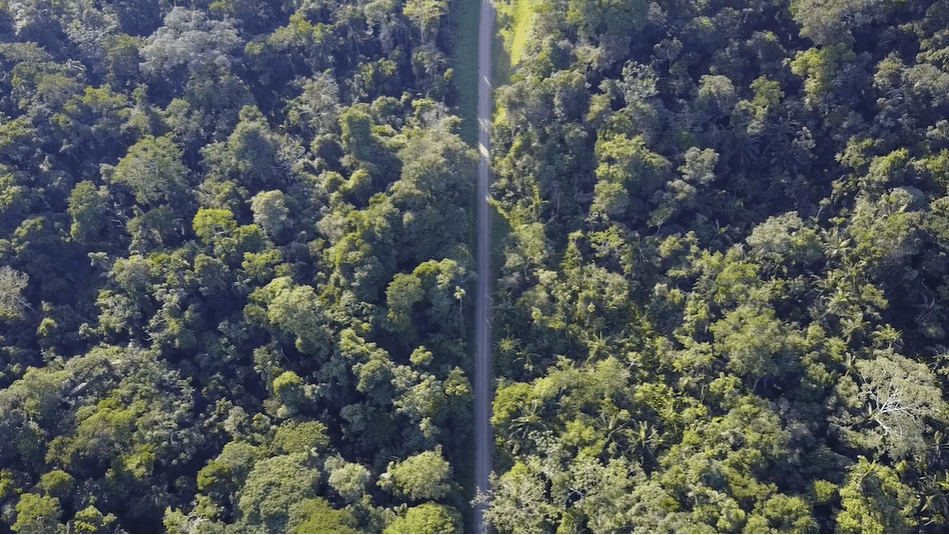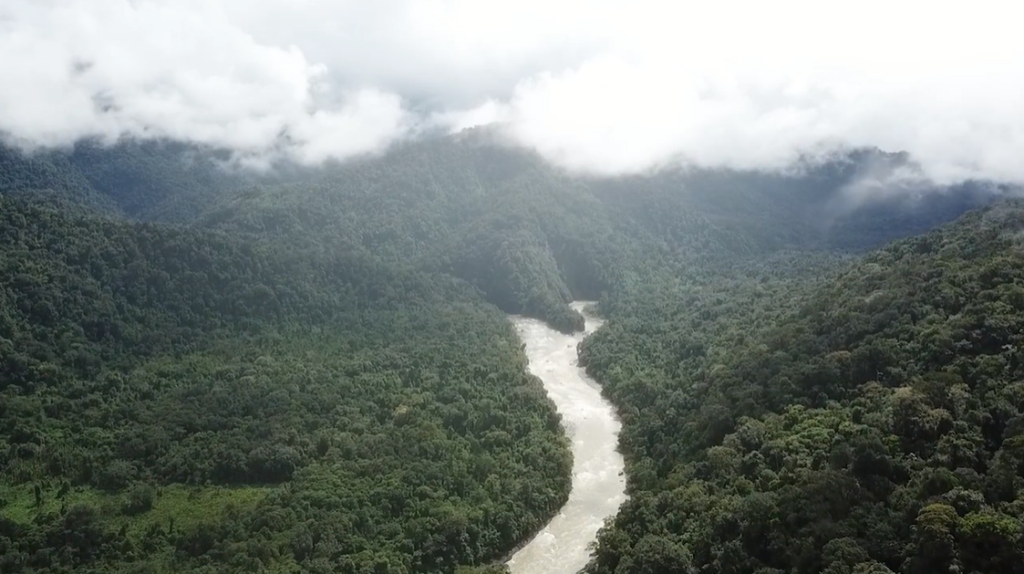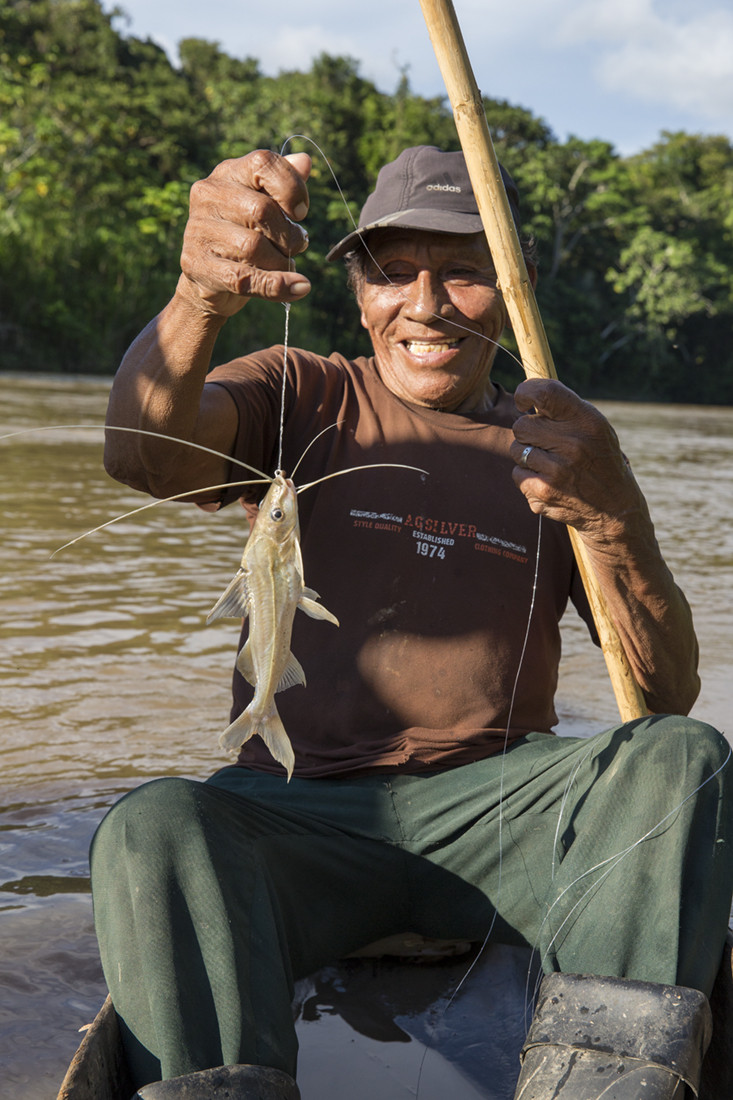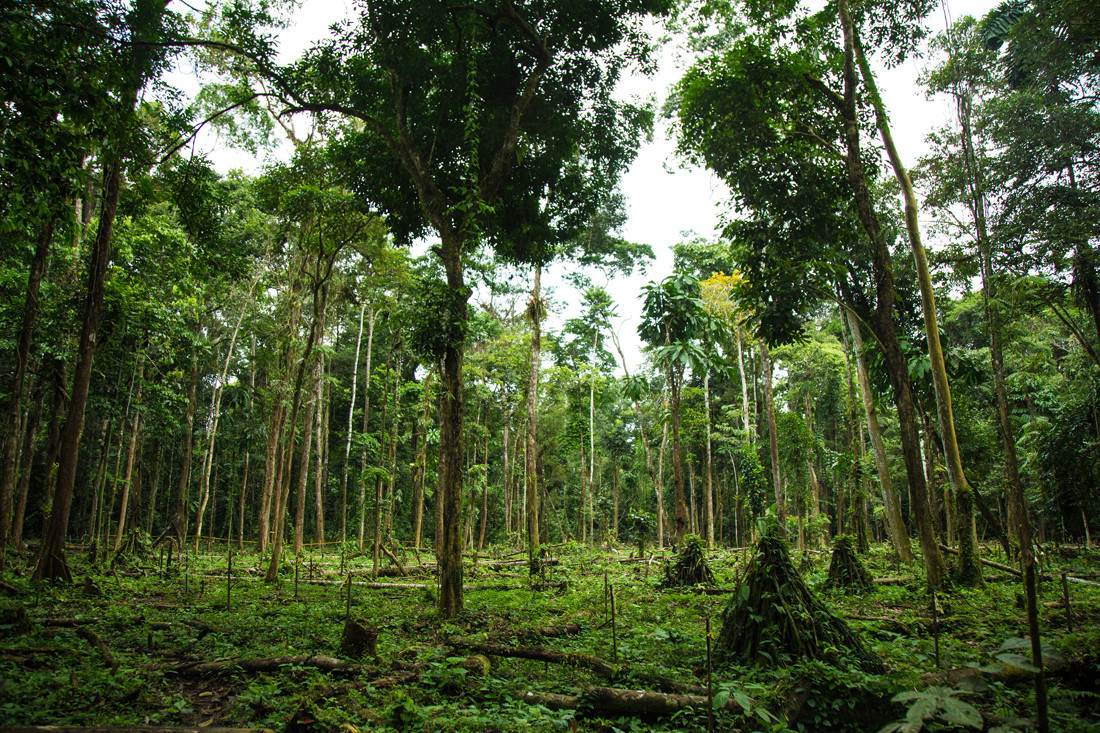
Drought in the wettest place on Earth, you ask? How could this be? Alas, since 2005, the Amazon has experienced “once in a century” dry conditions…every five years. The last drought, in 2015, is credited with having contributed to Sao Paulo’s much-talked-about water shortages. While most experts forecast higher precipitation in parts of Western Amazonia, they foresee the majority of this sodden forest drying out, morphing into a savanna, a transformation that some scientists are terming “dieback” (Cox et al, 2004). As for temperature projections, all point to hotter weather on the entire South American continent, with as much as a 4 to 5ºC increase expected in the eastern Amazon this century. (Duffy et al 2015).
To understand how the most humid forest on earth could wither and die, let’s look at the science. The Amazon forest creates over half of the rain that falls back on itself, through a process called evapotranspiration (Salati et al. 1979). When you reduce forest cover, you reduce rainfall. Deforestation rates in the Amazon vary by geographic region, but, overall, approximately 16 million hectares of forest was lost between 2000 and 2010 (Song et al. 2015). Forest fires, a common way of clearing land in eastern Amazonia, have two impacts in addition to their role in deforestation. First, they parch the surrounding standing forest, which then creates less rain (Lovejoy and Nobre, 2018). Second, fires lead to “rain shadows”: particles released into the air darken the sky making cloud formation more difficult and bind to water molecules in existing clouds, which are then less likely to jettison moisture (Cochrane and Laurance, 2008).

From 1990 to 2016, the Ecuadorian Amazon lost 650,000 hectares of pristine rainforest. This colossal encroachment on ancestral lands is occurring at an average rate of 110 American football pitches of forest cleared every day.
Another large chunk of the Amazonian deluge originates in the Atlantic Ocean (Chen 1985). The trees in the Amazon act as a pump that pulls moisture from the ocean, which then falls as rain over the forest. The currents created by the forest draw water from east to west. When this stream hits the Andes it is forced to dump some of its water and the rest continues south to Argentina and southern Brazil. This has been likened to a Flying River – a term coined by meteorologist Jose Marengo – running counter-current to the Amazon River and its tributaries. It is like a conveyor belt which replaces the water that is drained into the Atlantic Ocean everyday through the mighty terrestrial river, recycling it 5 to 6 times through evapotranspiration as it advances (Lovejoy and Nobre 2018). It is this Flying River that is faltering due to human activity, putting vast portions of the Amazon and southern South America at risk of drought.

Deforestation interrupts normal evapotranspiration volumes by removing the trees that create the rain. Meanwhile, as the temperature of the ocean rises due to climate change, the Atlantic jealously guards its water by moving the convection zone north (Marengo and Espinoza, 2016). These two factors together essentially curb the flow of the Flying River and dry out the forest making it more vulnerable to out-of-control forest fires, which further dry out the forest (Aragão et al, 2018). At the same time, drought switches the Amazon from a carbon sink (meaning it consumes more carbon than it lets off) into a carbon source as trees die off and decompose (Philipps et al. 2009); if the entire Amazon became a carbon emitter, the fallout would reach much farther than the South American continent. For example, a study concluded that total deforestation of the Amazon would result in a 10-20% decrease in rainfall in the coastal northwest US and up to 50% decrease in snowpack in the Sierra Nevada (Medvigy et al. 2013).
It is a nightmarish, triple feedback loop with a tipping point somewhere. Lovejoy and Nobre (2018) conclude “that the sensible course is not only to strictly curb further deforestation, but also to build back a margin of safety against the Amazon tipping point, by reducing the deforested area to less than 20%, for the common-sense reason that there is no point in discovering the precise tipping point by tipping it.”
 Ecuador, a country in which deforestation releases the equivalent annual carbon pollution of 34 million cars, is the 2018 host of the World Day to Combat Desertification and Drought. A recent study determined that the Amazon will be the most likely region of Ecuador to suffer climate change damage, partly due to human stressors, such as the opening of roads, which inevitably leads to forest loss, thus reducing adaptive capacity. (Eguiguren-Velepucha, 2016).
Ecuador, a country in which deforestation releases the equivalent annual carbon pollution of 34 million cars, is the 2018 host of the World Day to Combat Desertification and Drought. A recent study determined that the Amazon will be the most likely region of Ecuador to suffer climate change damage, partly due to human stressors, such as the opening of roads, which inevitably leads to forest loss, thus reducing adaptive capacity. (Eguiguren-Velepucha, 2016).
South American Lifeline

Indigenous people in the Ecuadorian Amazon depend on being able to read the elements to gauge their chances in different subsidence strategies; their ability to do this is compromised by unpredictable weather patterns.
The Flying River is a lifeline for millions of people living in the Amazon and further to the south, where it empties onto the continent as essential seasonal rains. An innovative project using participatory methods (Indigenous Health Adaptation to Climate Change (IHACC)) identified both climate-change induced flooding and water shortages as having health-related outcomes in two indigenous populations of the Western Amazon (Peru). Flooding episodes have become more intense and lead to the spread of water-borne disease (e.g. diarrhea) and vector-borne diseases (e.g. malaria and Leishmaniasis). Water shortages at other times force people to consume stagnant, murky water. Water shortages also lead to rice and palm crop failure, while high water yields fewer and smaller plantain. Additionally, villagers described suffering from the hot temperatures, reducing their agricultural work day from 6 to 3 hours. (Hofmeijer et al., 2012; Sherman et al. 2015) Drought has also been linked to respiratory problems, especially among children. In periods of dry weather, hospitalizations for respiratory complaints soar throughout the Brazilian Amazon due to irritating particles billowing up from dry soil and forest fire fumes. (Smith et al. 2014).
A changing climate also impacts the wildlife which communities depend on for their food. A recent study in Pacaya-Samiria Park in the Peruvian Amazon found that flooding led to a devastating 95% decrease in terrestrial mammals. On the other hand, flooding had positive impacts on fish numbers. Drought had the opposite effect on fish but not on terrestrial mammals. The indigenous diet is dependent on these natural resources and well balanced in normal conditions. But climate disruptions are triggering a shift in local food systems. Hunting frequency among the Cocama people in the area decreased from 84% of families to only 33% as game populations crashed following five consecutive years of flooding. The worst-case scenario is when drought follows several years of flooding. Mammal populations take some time to recover so in dry periods following inundations indigenous people wouldn’t be able to rely on either game or fish. (Bodmer et al. 2018).
Taming the Turning Tides of the Flying River
All indicators point to continued alterations in the Flying River. There are three lines of defence to this desiccation: 1) prevent further disturbances in the Amazon; 2) adapt to the new ebbs and flows; and 3) reduce global carbon emissions.
Local solutions for preventing further deterioration of the atmospheric currents include keeping forests intact and using traditional agroforestry systems. Protecting forests has wide-reaching consequences. According to the theory of the Flying River, a single stand of trees saved in Ecuador can have ripple effects across the entire Amazon Basin. Ecuador’s traditional agroforestry practices mitigate carbon emissions from cultivation through sequestering carbon in the trees that are grown alongside crops and feeding moisture to the Flying River (Torres et al. 2015).

Growing yoko in a forest plot.
In addition to promoting measures to mitigate climate change, communities will need to adapt. Relying on a diversified diet, which makes use of several ecological compartments will insulate people from some of the vagaries of a changing climate. Access to a stable source of sufficient water will prevent people from having to turn to rank pools in dried up river beds for their drinking water during short dry spells.

Rain-water catchment system.
Drought in the wettest place on Earth, you asked? The next logical question is, “What can I do?” The single biggest thing you can do to contribute to the maintenance of the Amazonian ecosystem and the traditional cultures dependent on it is to cut your carbon emissions. This is most effectively done by reducing fossil fuel consumption used in transportation and by eating lower on the food chain (less meat). So it is.
REFERENCE LIST
- Aragão, L. E. O. C., L. O. Anderson, M. G. Fonseca, T. M. Rosan, L. B. Vedovato, F. H. Wagner, C. V. J. Silva, C. H. L. Silva Junior, E. Arai, A. P. Aguiar, J. Barlow, E. Berenguer, M. N. Deeter, L. G. Domingues, L. Gatti, M. Gloor, Y. Malhi, J. A. Marengo, J. B. Miller, O. L. Phillips and S. Saatchi (2018). “21st Century drought-related fires counteract the decline of Amazon deforestation carbon emissions.” Nature Communications 9: 536.
- Chen, T.-C. (1985). “Global Water Vapor Flux and Maintenance during FGGE.” Monthly Weather Review 113(10): 1801-1819.
- Cochrane, M. A. and W. F. Laurance (2008). “Synergisms among Fire, Land Use, and Climate Change in the Amazon.” AMBIO: A Journal of the Human Environment 37(7): 522-527.
- Cox, P. M., R. A. Betts, M. Collins, P. P. Harris, C. Huntingford and C. D. Jones (2004). “Amazonian forest dieback under climate-carbon cycle projections for the 21st century.” Theoretical and Applied Climatology 78(1): 137-156.
- Duffy, P. B., P. Brando, G. P. Asner and C. B. Field (2015). “Projections of future meteorological drought and wet periods in the Amazon.” Proceedings of the National Academy of Sciences 112(43): 13172.
- Eguiguren-Velepucha, P. A., J. A. M. Chamba, N. A. Aguirre Mendoza, T. L. Ojeda-Luna, N. S. Samaniego-Rojas, M. J. Furniss, C. Howe and Z. H. Aguirre Mendoza (2016). “Tropical ecosystems vulnerability to climate change in southern Ecuador.” Tropical Conservation Science 9(4): 1940082916668007.
- Espinoza Villar Jhan, C., J. Ronchail, L. Guyot Jean, G. Cochonneau, F. Naziano, W. Lavado, E. De Oliveira, R. Pombosa and P. Vauchel (2008). “Spatio‐temporal rainfall variability in the Amazon basin countries (Brazil, Peru, Bolivia, Colombia, and Ecuador).” International Journal of Climatology 29(11): 1574-1594.
- Hofmeijer, I., J. D. Ford, L. Berrang-Ford, C. Zavaleta, C. Carcamo, E. Llanos, C. Carhuaz, V. Edge, S. Lwasa and D. Namanya (2013). “Community vulnerability to the health effects of climate change among indigenous populations in the Peruvian Amazon: a case study from Panaillo and Nuevo Progreso.” Mitigation and Adaptation Strategies for Global Change 18(7): 957-978.
- Lovejoy, T. E. and C. Nobre (2018). “Amazon Tipping Point.” Science Advances 4(2).
- Marengo, J. A. and J. C. Espinoza (2016). “Extreme seasonal droughts and floods in Amazonia: causes, trends and impacts.” International Journal of Climatology 36(3): 1033-1050.
- Medvigy, D., R. L. Walko, M. J. Otte and R. Avissar (2013). “Simulated changes in Northwest U.S. Climate in response to Amazon deforestation.” Journal of Climate 26(22): 9115-9136.
Salati, E., A. Dall ‘Ollio, E. Matsui and J. R. Gat (1979). “Recycling of water in the Amazon Basin: An isotopic study.” Water Resources Research 15(5): 1250-1258. - Sherman, M., J. Ford, A. Llanos-Cuentas, M. J. Valdivia and A. Bussalleu (2015). “Vulnerability and adaptive capacity of community food systems in the Peruvian Amazon: a case study from Panaillo.” Natural Hazards 77(3): 2049-2079.
- Smith, L. T., L. E. O. C. Aragão, C. E. Sabel and T. Nakaya (2014). “Drought impacts on children’s respiratory health in the Brazilian Amazon.” Scientific Reports 4: 3726.
- Song, X.-P., C. Huang, S. S. Saatchi, M. C. Hansen and J. R. Townshend (2015). “Annual Carbon Emissions from Deforestation in the Amazon Basin between 2000 and 2010.” PLOS ONE 10(5): e0126754.
- Torres, B., O. J. Maza, P. Aguirre, L. Hinojosa and S. Günter (2015). The contribution of traditional agroforestry to climate change adaptation in the Ecuadorian Amazon: The chakra system. Handbook of Climate Change Adaptation. W. Leal Filho. Berlin, Heidelberg, Springer Berlin Heidelberg: 1973-1994.
- Yoon, J.-H. and N. Zeng (2010). “An Atlantic influence on Amazon rainfall.” Climate Dynamics 34(2): 249-264.




